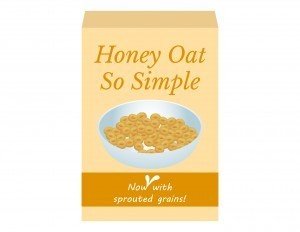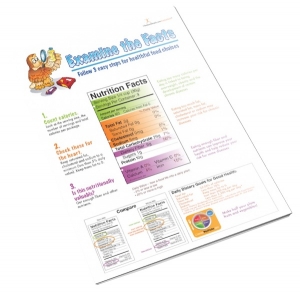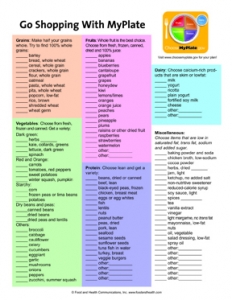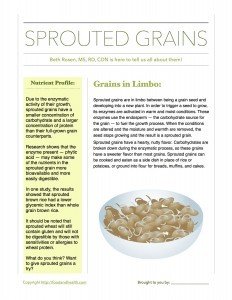The Skinny on Sprouted Grains
 Beth Rosen, MS, RD, CDN is here today to talk about a hot topic in the worlds of shopping, cooking, and healthful eating: sprouted grains.Sprouted grain products seem to be making their way to grocery store shelves as the new “power food.” But, what exactly are sprouted grains? Here’s the skinny on this new trend:Sprouted grains are in limbo between being a grain seed and developing into a new plant. In order to trigger a seed to grow, its enzymes are activated in warm and moist conditions. These enzymes use the endosperm -- the carbohydrate source for the grain -- to fuel the growth process. When the conditions are altered and the moisture and warmth are removed, the seed stops growing and the result is a sprouted grain.Sprouted grains must be cooked before eating in order to kill any potential food-borne pathogens that thrive in the warm and moist conditions the grains need to sprout. Commercial manufacturers control the environment of the sprouting seed and may offer a safer form of this “power food” than people would find when sprouting grains at home. Those with young or weakened immune systems should especially use caution when choosing to sprout grains at home.Due to the enzymatic activity of their growth, sprouted grains have a smaller concentration of carbohydrate and a larger concentration of protein than their full-grown grain counterparts. Research shows that the enzyme present, phytase, breaks down the phytic acid in sprouted grains. Phytic acid normally binds minerals found in unsprouted grains, but because the phytase activity is higher in sprouted grains, it breaks down phytic acid, thus increasing the bioavailability of the minerals in the grains. In one study, the results showed that sprouted brown rice had a lower glycemic index than whole grain brown rice. It should be noted that sprouted wheat will still contain gluten and will not be digestible by those with sensitivities or allergies to wheat protein.Sprouted grains have a hearty, nutty flavor. Carbohydrates are broken down during the enzymatic process, so they have a sweeter flavor than most grains. Sprouted grains can be cooked and eaten as a side dish in place of rice or potatoes, or used in place of flour in breads, muffins, and cakes (when in their ground form). Consumers can expect to see these new “power foods” throughout the supermarket aisles. They have already started to be incorporated into chips, cookies, and pastas.Looking for more wonderful grocery and shopping materials? The Nutrition Education Store has got you covered! We're here to help you look your very best, right now...
Beth Rosen, MS, RD, CDN is here today to talk about a hot topic in the worlds of shopping, cooking, and healthful eating: sprouted grains.Sprouted grain products seem to be making their way to grocery store shelves as the new “power food.” But, what exactly are sprouted grains? Here’s the skinny on this new trend:Sprouted grains are in limbo between being a grain seed and developing into a new plant. In order to trigger a seed to grow, its enzymes are activated in warm and moist conditions. These enzymes use the endosperm -- the carbohydrate source for the grain -- to fuel the growth process. When the conditions are altered and the moisture and warmth are removed, the seed stops growing and the result is a sprouted grain.Sprouted grains must be cooked before eating in order to kill any potential food-borne pathogens that thrive in the warm and moist conditions the grains need to sprout. Commercial manufacturers control the environment of the sprouting seed and may offer a safer form of this “power food” than people would find when sprouting grains at home. Those with young or weakened immune systems should especially use caution when choosing to sprout grains at home.Due to the enzymatic activity of their growth, sprouted grains have a smaller concentration of carbohydrate and a larger concentration of protein than their full-grown grain counterparts. Research shows that the enzyme present, phytase, breaks down the phytic acid in sprouted grains. Phytic acid normally binds minerals found in unsprouted grains, but because the phytase activity is higher in sprouted grains, it breaks down phytic acid, thus increasing the bioavailability of the minerals in the grains. In one study, the results showed that sprouted brown rice had a lower glycemic index than whole grain brown rice. It should be noted that sprouted wheat will still contain gluten and will not be digestible by those with sensitivities or allergies to wheat protein.Sprouted grains have a hearty, nutty flavor. Carbohydrates are broken down during the enzymatic process, so they have a sweeter flavor than most grains. Sprouted grains can be cooked and eaten as a side dish in place of rice or potatoes, or used in place of flour in breads, muffins, and cakes (when in their ground form). Consumers can expect to see these new “power foods” throughout the supermarket aisles. They have already started to be incorporated into chips, cookies, and pastas.Looking for more wonderful grocery and shopping materials? The Nutrition Education Store has got you covered! We're here to help you look your very best, right now...

 Here's a free handout with the details from today's post...
Here's a free handout with the details from today's post...


